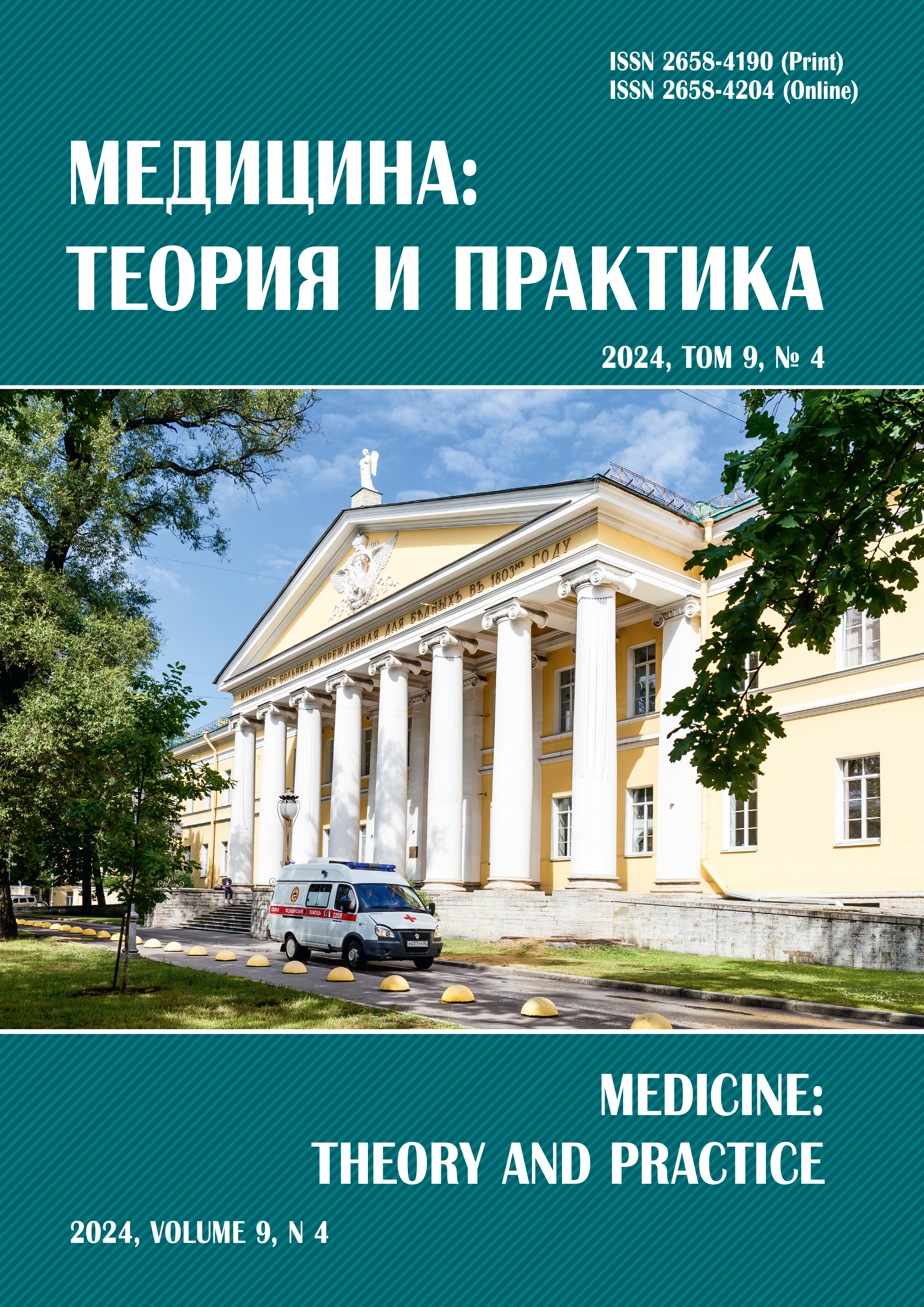CURRENT ROLE OF CAPTOPRIL-RENOSCINTIGRAPHY IN THE DIFFERENTIAL DIAGNOSIS OF RENOVASCULAR HYPERTENSION IN PATIENTS WITH CHRONIC KIDNEY DISEASE
Abstract
Chronic kidney disease (CKD) is a globally significant health problem, reaching a population prevalence of approximately 15%. An important risk factor for CKD is the growth and progression of arterial hypertension (AH), due to the vicious circle of cause-and-effect relationships of these pathologies. Hypertension in patients with CKD occurs in 70% of cases. Almost 90% of patients suffer from hypertension in the later stages of CKD. Comparison of separate renal function before and after captopril is the simplest and most commonly used semi-quantitative parameter to assess changes in renal function. This parameter is quite sensitive in patients with unilateral functionally significant renal artery stenosis. Captopril renography is an important diagnostic test. It plays a role in the differential diagnosis of treatable renovascular hypertension and may play a large and far-reaching role in assessing the safety of angiotensin-converting enzyme inhibitor therapy in patients with reduced renal function and hypertension.
References
Horowitz B., Miskulin D., Zager P. Epidemiology of Hypertension in CKD. Adv Chronic Kidney Dis. 2015;22(2):88–95. DOI: 10.1053/j.ackd.2014.09.004.
Kalaitzidis R.G., Elisaf M.S. Treatment of Hypertension in Chronic Kidney Disease. Curr Hypertens Rep. 2018;20(8):64. DOI: 10.1007/s11906-018-0864-0.
Valika A., Peixoto A.J. Hypertension Management in Transition: From CKD to ESRD. Adv Chronic Kidney Dis. 2016;23(4):255–61. DOI: 10.1053/j.ackd.2016.02.002.
Agarwal R., Flynn J., Pogue V., Rahman M., Reisin E., Weir M.R. Assessment and management of hypertension in patients on dialysis. J Am Soc Nephrol. 2014;25:1630–646. DOI: 10.1681/ASN.2013060601.
Van Buren P.N., Inrig J.K. Special Situations: Intradialytic Hypertension/Chronic Hypertension and Intradialytic Hypotension. Semin Dial. 2017;30(6):545–552. DOI: 10.1111/sdi.12631.
Hamrahian S.M., Falkner B. Hypertension in Chronic Kidney Disease. Adv Exp Med Biol. 2017;956:307–325. DOI: 10.1007/5584_2016_84.
Ku E., Lee B.J., Wei J., Weir M.R. Hypertension in CKD: Core Curriculum 2019. Am J Kidney Dis. 2019;74(1):120–131. DOI: 10.1053/j.ajkd.2018.12.044.
Qian Q. Salt. Water and Nephron: Mechanisms of Action and Link to Hypertension and Chronic Kidney Disease. Nephrology (Carlton). 2018;23(Suppl 4):44–49. DOI: 10.1111/nep.13465.
Nongnuch A., Campbell N., Stern E., El-Kateb S., Fuentes L., Davenport A. et al. Increased postdialysis systolic blood pressure is associated with extracellular overhydration in hemodialysis outpatients. Kidney Int. 2015;87:452–457. DOI: 10.1038/ki.2014.27.
Williams G.H. Converting-enzyme inhibitors in the treatment of hypertension. N Engl J Med. 1988;319(23):1517–1525. DOI: 10.1056/NEJM198812083192305.
Keane W.F., Anderson S., Aurell M., Zeeuw D. de, Narins R.G., Povar O. Angiotensin converting enzyme inhibitors and progressive renal in sufiuciency. Ann Intern Med. 1989;111(6):503–516. DOI: 10.7326/0003-4819-111-6-503.
Hricik D.E., Browning P.J., Kopelman R., GoornoW.E., Madias N.E., Dzau V.J. Captopril-induced functional renal insufficiency in patients with bilateral renal arteiy stenosesor renal artery stenosis in a solitary kidney. N Engl J Med. 1983;308(7):373–6. DOI: 10.1056/NEJM198302173080706.
Rimmer J.M., Gennari F.J. Atherosclerotic renovascular disease and progressive renal failure. Ann Intern Med. 1993;118(9):712–719. DOI: 10.7326/0003-4819-118-9-199305010-00010.
Rudnick M.R., Berns J.S., Cohen R.M., Goldfarb S. Contrast media-associated nephrotoxicity. Semin Nephrol. 1997;17(1):15–26.
Mann S.J., Pickering T.G., Sos T.A., Uzzo R.G., Sarkar S., Friend K., Rackson M.E., Laragh J.H.. Captopril renography in the diagnosis of renal artery stenosis: accuracy and limitations. Am J Med. 1991;90(1):30–40. DOI: 10.1016/0002-9343(91)90503-p.
Chosdhri A.H., Cleland J.G., Rowlands P.C., Tran T.L., McCarty M., Al-Kutoubi M.A. Un suspected renal artery stenosis in peripheral vascular disease. BMJ. 1990;301(6762):1197–1198. DOI: 10.1136/bmj.301.6762.1197.
Datseris I.E., Bomanji J.B., Brown E.A., Nijran K.S., Padhy A.K., Siraj Q.H., Britton K.E. Captopril renal scintigraphy in patients with hypertension and chronic renal failure. J Nucl Med. 1994;35(2):251–254.
Sfakianakis G.N., Bourgoignie J.J., Jaffe D., Kyriakides G., Perez-Stable E., Duncan R.C. Single-dose captopril scintigraphy in the diagnosis of renovascular hypertension. J Nucl Med. 1987;28(9):1383–1392.
Saddler M.C., Black H.R. Captopril renal scintigraphy — A clinician's perspective, in Hoffer P.B. (ed): The Year Book of Nuclear Medicine. Littleton, MA, Year Book Medical; 1990: XIII–XXXIV.
al-Nahhas A., Marcus A.J., Bomanji J., Nimmon C.C., Dacie J.E., Britton K.E. Validity of the mean parenchymal transit time as a screening test for the detection of functional renal artery stenosis in hypertensive patients. Nucl Med Commun. 1989;10(11):807–815. DOI: 10.1097/00006231-198911000-00005.
Zawada E.T. Jr, Clements P.J., Furst D.A., Bloomer H.A., Paulus H.E., Maxwell M.H. Clinical course of patients with scleroderma renal crisis treated with captopril. Nephron. 1981;27(2):74–78. DOI: 10.1159/000182028.
Dubovsky E.V., Russell C.D. Diagnosis of renovascular hypertension after renal transplantation. Am J Hypertens. 1991;4(12 Pt 2):724S–730S. DOI: 10.1093/ajh/4.12.724s.



